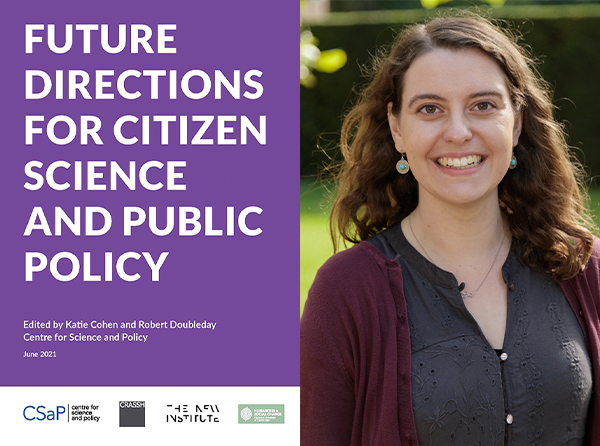Katie Cohen, Researcher at the Centre for Science and Policy (CSaP) and Research Assistant at CRASSH’s Expertise Under Pressure Research Project tells us about the book Future directions for citizen science and public policy she co-edited with Robert Doubleday, Director of CSaP and Co-Investigator of EUP.

Q. What is your book Future directions for citizen science and public policy about?
The book illustrates the benefits of citizen science, a diverse set of participatory practices by which individuals contribute their knowledge to scientific and policy processes. Collating citizen science case studies and perspectives across various policy domains, it shows how making use of citizen science can lead to more effective and inclusive decision-making. The book also begins to chart the way forward for governments to integrate citizen science practices into public policy.
Q. What drew you to the subject and what do you find particularly interesting about it?
At the Centre for Science and Policy (CSaP), we have seen a growing imperative in government to find new ways to involve citizens as partners in the development and delivery of policy. At the same time, we have seen a flourishing of citizen science experiments and the increasing embrace of these approaches by scientific communities. But to date there have been surprisingly few experiments with citizen science by government itself. As the UK government continues to navigate a way through the challenges posed by the COVID-19 pandemic, we thought it important and timely to consider how citizens’ knowledge can make a more active contribution to science and government.
Q. Around which themes did you decide to structure the book, and to what end?
The cross-cutting themes we explore in the book are data quality, diversity and inclusion and infrastructures of citizen engagement. We chose to divide the book into three sections: Democratising science and policy, Cultures of engagement and Publics, Participation and Governance. These divisions allow the reader to begin with broad perspectives on the potential of citizen science for policy, then move to domain specific examples and conclude with new ways for policy makers to activate citizen knowledges.
Q. In your view, wherein lies the book’s main contribution to our understanding of citizen science and public policy?
The book provides concrete case studies about integrating citizen science into public policy across a range of policy areas, including health and wellbeing, environmental monitoring, food regulation, local decision-making and the data economy. It advocates greater use of citizen science by governments, while also addressing policy makers’ concerns and institutional barriers.
Q. What would readers be surprised to learn about in your book?
Readers might be surprised to learn that citizen science comes in many forms. The book explores use of online platforms, air pollution sensor kits, citizens assemblies, co-produced research and other varieties of participatory practices. By considering a plurality of citizen sciences, the book opens up new ways for citizen science to democratise science and policy.
- This book is available Open Access (some rights reserved). Download the e-book.
- Published by the Centre for Science and Policy, June 2021 © Centre for Science and Policy.

